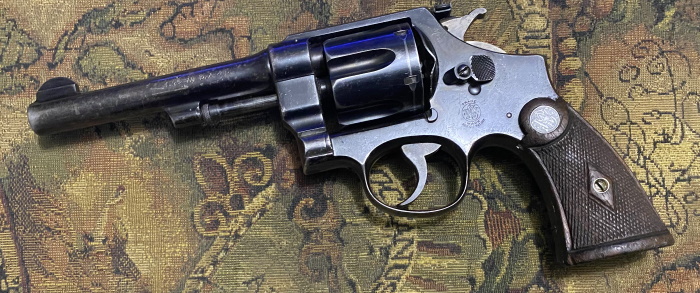
The Colt M1911 was the US standard service pistol at the dawn of WW1, but existing stocks of these were inadequate when the US joined the war in Europe. Both Colt and Smith & Wesson were approached to produce versions of their large-frame revolvers in .45 ACP. Colt adapted the M1909 New Service and S&W made a version of their .44 Hand Ejector (2nd Model) chambered for the new cartridge. Both revolvers used 3-shot spring-steel clips to accommodate the rimless cartridge. These weapons were used in WW1 and WW2, and were even issued to support troops in the Korean War.
Between wars the guns were offered on the civilian market, and were popular both with individuals and law enforcement. Eventually a 6-round ‘full moon’ clip was offered, but these could be difficult to remove cartridges from so the were not universally preferred. These clips were also more prone to bending, which could interfere with cylinder rotation and could jam the revolver. Good-quality modern clips are much less prone to this issue.
The Brazilian Contracts
In 1937 Brazil contracted S&W for 25,000 commercial models for use by their military and some police units. These guns had the Brazilian government crest on the right side plate in place of the normal S&W logo. A small S&W logo was engraved on the left side of the frame. The contract was filled primarily with standard flat-top frames with a square-notch trough-style fixed rear sight with a square sight notch. The guns had a 5-1/2″ barrel and checkered wooden stocks.
A second order was placed in 1946 for some 11,000-12,000 guns. These were much more a mixed bag, with some using round-topped WW1-era frames with a U-notch rear sight. Some were provided with smooth wooden grips, and some had the later checkered grips. Serial numbers for these guns can be confusing, with the early-style frames actually having lower serial numbers than the guns from the 1937 contract and other guns having higher serial numbers.
When these gun were phased out in Brazil many were re-imported to the United States, and they are still available at a lower price than former US service guns or commercial models.
My 1917
I ran across a 1st-contract gun at Pinto’s Guns at a very decent price and snatched it up. It was a standard gun, missing the lanyard-ring and equipped with an aftermarket adjustable sight (more on that later.) It’s in pretty good shape, with a clean, shiny bore, tight and with a very good trigger. The finish is definitely showing it’s age but isn’t too bad. It’s equipped with the standard commercial checkered grips. Interestingly it has the old-style ‘mushroom-head’ ejector rod, which had been replaced on I and K-frames in 1928.
It’s a Wonder!
In the aftermath of WW2 a lot of S&W revolvers became available as surplus at bargain prices. These were all fixed-sight guns, mostly M&Ps and Model 1917s. In 1953 FDL introduced an adjustable sight that could be installed by anyone with a screwdriver. It worked on all 5-screw guns, I-frames, K-frames and N-frames. This allowed a lot of folks with surplus guns to make a target gun on the cheap, and while they do not offer as good a sight picture as a factory adjustable sight they worked and were affordable.
Elevation can be adjusted by loosening the mounting screw and sliding the body of the sight up and down, and windage is adjusted by a click-adjustable knob on the right side of the sight.
Shooting the Model 1917
Taking the gun and fifty rounds of my go-to reload for .45 ACP, a 200gr. RNFP lead bullet over 6.2gr. of Universal with a Winchester WLP primer, I grabbed some clips and headed to the range. The stock grips felt alright in my hand, and the gun is as accurate as one would expect. No rapid-fire groups this time, however; while recoil isn’t harsh it’s not trivial either, and with the stock grips the gun shifts in my hand with each shot.
Yeah, About Those Clips…
I mentioned that unloading clips is difficult? I may nave understated that;… it’s a proper pain-in-the-butt. It kind of has to be; they need to stay in place, not just in the cylinder but in a pouch or pocket as well. You can easily make a tool for unloading these however. You can use a simple metal tube with a 1/2″ inside diameter. I used a short section of .45 barrel reamed out to 1/2″. You cut one end back so there is a protruding flange, slip it over the cartridge with the flange extending past the clip on the outside and twist. Easy-peasy. The flange levers the cartridge right out.
Moon clips allow positive ejection and fast reloads, but you don’t want to go cheap; a bent clip will jam your revolver up in a hurry!
I Have Plans For You, My South-American Beauty!
I’ve already accomplished my first evil plan, which was to make a new set of grips to fit my hand. So what’s next? Bobbing the barrel? Turning it into a ‘Fitz Special? Mounting a telescopic night-sight? Uh, no.
I’ll need to make a holster or two, and I’d love to shoot some action shooting matches. If I get really crazy I might polish the grooves off the trigger-face, but that’s about the limit. With the new grips I like the gun just as it is, so I plan to leave it alone.
“Yeah, but what you plan and what takes place ain’t never but similar.”
Oh shut up.
Stay safe and take care.
Michael Tinker Pearce, 8 October 2021
If you like what you see here, please consider clicking the link above and supporting me on Patreon.
Pingback: Range Time! | Tinker Talks Guns